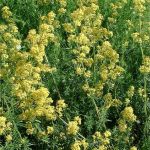| Common Name: |
Cheese Rennet |
| Other Names: |
Lady's bedstraw, Yellow Bedstraw |
| Botanical Name: |
Galim verum |
| Genus: |
Galium |
| Family: |
Rubiaceae |
| Native Location: |
Europe, W Asia, N America |
| Cultivation: |
Moist, well-drained, neutral to alkaline soil in shade. G. verum prefers drier, sunny conditions. |
| Propagation: |
By seed sown when ripe; by division in autumn or early spring. |
| Harvest: |
Plants are cut when flowering and dried for infusions, liquid extracts, and tablets. Galium aparine is usually used fresh, either juiced or in oil for external use. Seeds are collected when ripe. |
| Height: |
15cm-1m (6-36in) |
| Width: |
Indefinite |
| Hardiness: |
Z3-8 |
| Parts Used: |
Whole plant |
| Properties: |
An astringent, acidic, slightly bitter herb that is alterative and diuretic, and relaxes spasms. |
| Medicinal Uses: |
Internally for kidney, bladder and urinary complaints |
| Culinary Uses: |
Flowering tops are used to curdle milk for making cheese. |
| Bibliography: |
Encyclopedia of Herbs by Deni Brown Copyright © 1995, 2001 Dorling Kindersley Limited. pg 219 |

